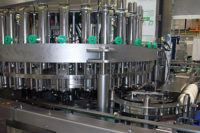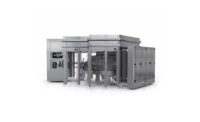“Can-makers have dramatically increased their variety of can sizes and shapes, primarily to accommodate the demand of beverage companies wanting to differentiate their products and packages,” says John Wagg, sales and operations manager for CMC-Kuhnke, Albany, N.Y. “Additional factors have also contributed, such as adherence to new regulations in air travel and school meal programs. The sheer number of different beverage cans on the market provides a challenge for those filling and handling cans.”
In addition, the aluminum bottle and resealable can closure have created new challenges within the category, Wagg notes. The adoption of cans by craft brewers also has expanded the demand for can filling, seaming and inspection options.
Filling needs
Krones Inc. is reaching out to more craft brewers regarding its can filling equipment, says Barry Fenske, product manager of the filling division for the Franklin, Wis.-based company. The company offers two types of can fillers: one uses a metering chamber to measure the quantity of product put inside the can and the other uses a flow meter, Fenske explains. These systems can fill between 10,000 and 130,000 cans each hour depending on the product, according to Krones.
Krones’ Volumetric VOC line of fillers supplies the required amount of product for each filling valve in a precision-made metering chamber. A high-resolution trans-sonar probe is used to determine exactness in dosing, the company says. The filler’s centering unit is controlled by a cam roller that raises the centering unit as the can enters the filler. The electro-pneumatic filling valve opens once the centering element has been lowered and the filling valve is given the signal to close as soon as the magnetic float in the metering chamber has fallen, the company explains.
In contrast to the aforementioned model, the company’s Volumetric VODM-C ensures the correct fill quantity by using an inductive flow meter. The meter is located in each product feed pipe upstream of the filling valve and determines the amount of product flowing in the pipe by measuring the electrical conductivity.
Both options offer the benefit of the ability to optimize speed for each can size and product mix as well as extremely accurate fills, Fenske says. “There are no limiting fixed cams and actuators that initiate the different filling phases; both of our can fillers utilize electro-pneumatic control. The customer has the ability to dial in and optimize each recipe through the operator touch screen,” he says.
Krones also keeps an eye on trends and customer needs, Fenske says. “Just as soon as a new idea or opportunity is discovered, we are hard at work on the ‘drawing board’ and in the lab to see how to best meet that need,” he says.
Volumetric filling also is offered by Waukesha, Wis.-based KHS USA Inc., which offers the Innofill Can DVD model, a computer-controlled can filler that is able to process beer, carbonated soft drinks, juices, still beverages, ready-to-drink coffee and tea drinks. The Innofill’s volumetric filling principle ensures maximum fill level accuracy on a variety of cans, according to the company. The model is able to fill at speeds up to 120,000 cans each hour, KHS says.
Seaming demands
The variety in can shapes and sizes has challenged can seamer manufacturers to offer machinery that is able to adapt easily. Shoreline Packaging and Processing Machinery, Havre de Grace, Md., is the U.S. representative of Swiss-based Ferrum’s full range of can seamers, which have been designed to accommodate a variety of applications in the beverage industry.
Ferrum’s most recent innovation is the release of the Easy Rider seaming roll, which was designed to have less friction surfaces in the center of the seaming roll to allow the seamer to run with less torque. Suitable for sealing steel and aluminum ends, the Easy Rider seaming roll has a ceramic bearing and coating that enable it to seal about 70 million cans before replacement is required.
Addressing another industry issue, Ferrum introduced an infeed table that was developed according to the criteria of hygienic design in late 2010. The infeed table was designed with round surfaces and open construction to allow for easier access for cleaning. It features cleaning nozzles that are welded directly on the supporting pipe and link to one of the two basic supports, which carry the cleaning solution or water. In addition, the table was constructed modularly so that it can be uncoupled from the seamer, the company says.
All Ferrum seamers use the existing machine lubrication system to lubricate the seaming rolls, which eliminates the need for grease on the seamer, the company says. In addition to low- and mid-range speeds, Ferrum offers high-speed seamers with a quick-change option to allow for changeovers in less than two hours, according to the company. Ferrum also has developed a lid feed system that is specifically designed to operate at the slower speeds required by new resealable can closures used by some beverage-makers.
In addition to offering new Ferrum machinery, Shoreline Packaging and Processing Machinery also offers complete rebuilds for its customers’ existing machinery. The company has seen an increase in this side of its business due to the economic downturn as well as the availability of more affordable after-market parts, it says.
Quality assurance
Industry trends also have had an effect on CMC-Kuhnke’s portfolio of seam measurement and inspection tools. All of the company’s semi-automated products, including the new CSG-2360 Combination Seam Gauge, are designed to work with a wide range of cans, Wagg explains. The CSG-2360 model automatically adapts to multiple can diameters and is can-height independent, he says. It has the ability to run in standard mode, which provides automated seam thickness and countersink depth measurements, or 360-mode, which gives a complete seam thickness profile of a can.
Also addressing the advent of the resealable can closure, CMC-Kuhnke developed opening force gauges in collaboration with Ball Packaging Europe, which designed the resealable beverage closure. The systems are used to measure the loose ends during the production phase as well as the seamed cans in the filling environment, Wagg says.
The company also developed a new measurement technology that is non-destructive, eliminates product spoilage and saves time of inspection of the double seams on cans, Wagg says. In early 2011, CMC-Kuhnke launched the XTS line of non-destructive double-seam inspection systems. The SeamScan XTS provides automatic, non-destructive measurement for double-seam inspection through the use of x-ray seam imaging technology that measures seam height, body hook, cover hook, overlap and seam gap, the company says. The line also includes the fully automated Mars-XTS, which combines the internal x-ray seam measures of the SeamScan XTS with the CSG series combination seam gauge for external seam measurements, Wagg explains. BI





